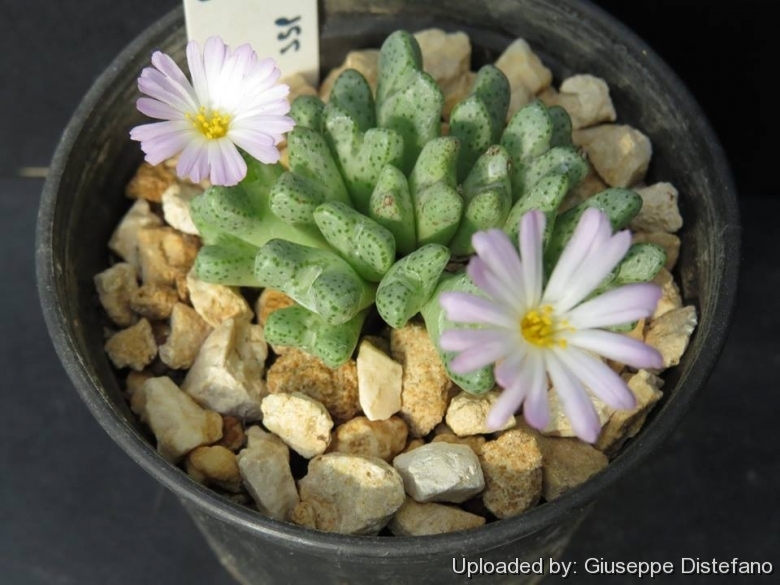Accepted Scientific Name: Conophytum tantillum subs. eenkokerense (L. Bolus) S.A.Hammer
Dumpling & His Wife: New Views of Gen. Conophytum 265 (2002) S.A.Hammer

Conophytum eenkokerense (Conophytum tantillum subs. eenkokerense) Photo by: Giuseppe Distefano
Origin and Habitat: Jakkalswater, (a.k.a. Kon Kiep or Eenkokerberg) north of Eenriet, in the Eenkoker Mountains (Geelvlei plateau), Bushmanland, Northern Cape, South Africa , it may extend southward.
Habitat and ecology: It grows in shade in few quartzite hills.
Synonyms:
See all synonyms of Conophytum tantillum
Common Names include:
JAPANESE (日本語): コノフィツム・エエンコケレンセ
Description: Conophytum tantillumSN|18625]]SN|18625]] subs. eenkokerense is a small densely branched species with markings consisting of linked green spots. It is closer to Conophytum tantillumSN|18625]]SN|18625]] subsp. helenae in pattern and angularity. Probably the closest subspecies.
Habit: Plants characterised by small, two-lobed plant bodies forming tight or loose flat mats that “retracts” as summer approaches, and then the sheaths are tightly sealed over the bodies.
Stem: It is almost stemless.
Bodies (paired leaves): Up to 10 mm tall, 8-10 mm in wide and about 6 mm thick, cone-shaped or cylindric below, apex wedged, bibbed, the widely gaping cleft is usually round or elliptical, epidermis trichomous, greyish-green, yellowish-green or reddish, with green or red linked spots, but not striations, sheaths brown very firm.
Flowers: Petals pink or white. They are simple, daisy-like, early diurnal.
Blooming season: They arise at the beginning of the growing period in September to October. Seedlings are capable of bearing flowers within 2 to 3 years.
Fruit: 4-5 locular.
Subspecies, varieties, forms and cultivars of plants belonging to the Conophytum tantillum
 Conophytum tantillum N.E.Br.: Petals white to pinkish. Leaves greyish-green, plant polyploid. Distribution: Northern Cape, South Africa. Geelvlei Plateau around Steinkopf and Springbok
Conophytum tantillum N.E.Br.: Petals white to pinkish. Leaves greyish-green, plant polyploid. Distribution: Northern Cape, South Africa. Geelvlei Plateau around Steinkopf and Springbok Conophytum tantillum subs. amicorum S.A.Hammer & Barnhill: Bodies thick, always unlined, subtly keeled.Flowers yellow. Distribution: South west of Steinkopf, Northern Cape, South Africa
Conophytum tantillum subs. amicorum S.A.Hammer & Barnhill: Bodies thick, always unlined, subtly keeled.Flowers yellow. Distribution: South west of Steinkopf, Northern Cape, South Africa Conophytum tantillum subs. eenkokerense (L. Bolus) S.A.Hammer: has body-markings consisting of linked green spots.
Conophytum tantillum subs. eenkokerense (L. Bolus) S.A.Hammer: has body-markings consisting of linked green spots. Conophytum tantillum subs. helenae (Rawé) S.A.Hammer: Petals magenta. Distribution: Namaqualand, Northern Cape, South Africa.
Conophytum tantillum subs. helenae (Rawé) S.A.Hammer: Petals magenta. Distribution: Namaqualand, Northern Cape, South Africa.- Conophytum tantillum subs. inexpectatum S.A.Hammer: Bodies slender, usually lined with red or green, glabrous.
- Conophytum tantillum subs. lindenianum (Lavis & S.A.Hammer) S.A.Hammer: Leaves yellowish-green, plant diploid.
Bibliography: Major references and further lectures
1) Matlamela, P.F. & Kamundi, D.A. 2008. Conophytum tantillum N.E.Br. subsp. eenkokerense. National Assessment: Red List of South African Plants version 2013.1. Accessed on 2014/01/30
2) Nicholas Edward Brown, A. Tischer, M. C. Karsten “Mesembryanthema; Descriptions: With Chapters on Cultivation and General Ecology” L. Reeve, 1931
3) Gordon D. Rowley “The illustrated encyclopedia of succulents” Crown Publishers, 01/Aug/1978
4) James Cullen, Sabina G. Knees, H. Suzanne Cubey “The European Garden Flora Flowering Plants: A Manual for the Identification of Plants Cultivated in Europe, Both Out-of-Doors” Cambridge University Press, 11/Aug./2011
5) Hammer, S. 1993. “The Genus Conophytum - A Conograph.” Succulent Plant Publications, Pretoria.
6) Hammer, S. 2002. “Dumpling and His Wife: New Views of the Genus Conophytum.” East Anglia Engraving Creative Colour Ltd, Norwich, England.
7) Ernst Van Jaarsveld, Ben-Erik Van Wyk, Gideon Smith “Succulents of South Africa: A Guide to the Regional Diversity” Tafelberg Publishers, Limited, 01/lug/2000
8) Heidrun E.K. Hartmann “Illustrated Handbook of Succulent Plants: Aizoaceae A-E” Springer, 2002
9) Werner Rauh “The Wonderful World of Succulents: Cultivation and Description of Selected Succulent Plants Other Than Cacti” Smithsonian Institution Press, 1984
10) Hermann Jacobsen “Lexicon of Succulent Plants” Littlehampton Book Services Ltd. 1974
 Conophytum eenkokerense (Conophytum tantillum subs. eenkokerense) Photo by: Valentino Vallicelli
Conophytum eenkokerense (Conophytum tantillum subs. eenkokerense) Photo by: Valentino VallicelliSend a photo of this plant.The gallery now contains thousands of pictures, however it is possible to do even more. We are, of course, seeking photos of species not yet shown in the gallery but not only that, we are also looking for better pictures than those already present.
Read More... Cultivation and Propagation: It is relatively easy to grow. These plants grow on winter rain and head for summer dormancy. More or less dormant in summer.
Soil: Use well-drained soil mix.
Water: The plant requires little water; otherwise its epidermis breaks (resulting in unsightly scars). Water throughout the year although minimally in summer, (only when the plant starts shrivelling), but it will generally grow even in summer if given water. Water regularly in winter after the previous year's leaves have dried up. Requires good drainage.
Exposure: Plants prefer morning sun and some protection against afternoon hot sun in mid-summer; it needs full sun or light shade in the other seasons. Keep dormant in summer and keep protected during this period.
Hardiness: Hardy to -2°C. Ensure a very good ventilation.
Maintenance: Avoid to repot frequently. This plant may stay in the same pot for many years. Plants grown in larger containers have frequently relatively poor flowers. It might improve when the plants are given their own, small individual pots. With age the plants can grow raggedly leggy and it is best to renew them from cuttings.
Propagation: It can be reproduced both by cuttings and seeds. Take the cutting from a grown-up mother plant. Each cutting must contain one or more heads, along with a fraction of root.











